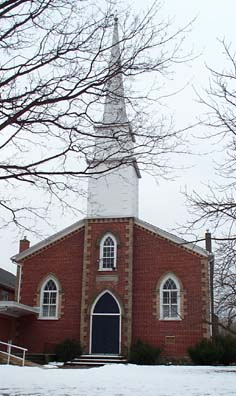 |
115 St. Andrew's Rd Toronto ON M1P4N2 Be sure to vist St. Andrew's Web Site photo by Robert Sewell "Discover a Toronto you never knew" Toronto's Lost Villages
Polar Bear Press
|
The following is an excerpt from
Ron Brown: Toronto's Lost Villages,
Polar Bear Press, Toronto 1997 pages 119 - 120
see below for details.
Bendale represents Scarborough’s most historic site, the place where settlement began. Here, where an early version of Markham Road wound its way northeastward, David Thomson and his brother Andrew erected their crude shanties. The year was 1797. Yonge Street was only a year old, and Asa Danforth had yet to clear the dense forests for his road east. It was a particularly difficult time to be trying to locate and clear land in what was then a daunting forest.
The community at first went by the name of Benlomond and was centred on Danforth Road and Lawrence. However, that name was also used for a community near Norway on the Kingston Road, and, when it came time to find a name for the post office, Bendale was chosen.
The community was more a scattered rural community rather than a concentrated village. A short distance from the Thomsons, John Wheler constructed a sawmill on the west side of Bellamy and south of Lawrence, and shortly thereafter a grist mill. The grist mill burned down in 1863.
In the 1840s, the Thomson brothers’ sons built new houses, James building the house he called “Springfield” east of the family homestead, and William adding “Bonese” to the west. Between the two, the community added a handsome brick church, beside which a library building was added in the 1890s. A quiet farm road twisted its way past the Thomsons and the church connecting Brimley and McGowan. During this period, the Thomson family controlled most of the farmland between Kennedy and Brimley, and between Lawrence and Ellesmere. The Canadian Northern laid its rail line across the Thomson land, but surprisingly, never added a station.
The suburban tide rolled through this area during the 1960s. Remarkably, it spared much of Bendale. This preservation victory is due to the foresight of the hardworking members of the Scarborough Historical Society, who managed to save the church, the library building and both Thompson houses. All stand today on St. Andrews Road, and are celebrated with historic plaques. The road itself has retained much of its early characteristics, narrow and winding as it passes through the woodland that yet surrounds the old church, a miniature landscape from the past.
“Springfield” has been designated as a heritage structure, and holds roots for such Canadian luminaries as Lord Thomson of Fleet, and Farley Mowat. Further west, where St. Andrews meets Brimley, the elegant stone Bonese is also designated “historic”.
On the south bank of Highland Creek is the Scarborough museum with a pioneer log cabin and the 1858 Cornell family farm house. Even a portion of the long-abandoned Canadian Northern right of way has become a footpath through the park. Meanwhile, closer to Ellesmere, the Wheler house has also been saved, and is now part of the Bendale Bible Chapel.
 |
115 St. Andrew's Rd Toronto ON M1P4N2 Be sure to vist St. Andrew's Web Site photo by Robert Sewell "Discover a Toronto you never knew" Toronto's Lost Villages
Polar Bear Press
|
Click to return to the Thomson Family Introductory Page.
Click to return to the top of this page.